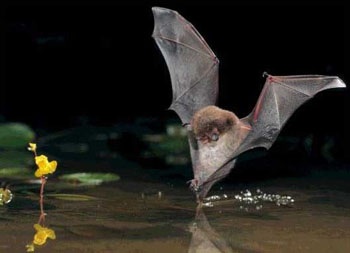
In what should put yet another nail in the coffin of people who oppose wind farms, researchers have discovered that radar systems seem to drive bats away. Making it a possible way to keep bats from running into wind turbines. Researchers at the University of Aberdeen believe they may have found a solution to a problem that they worry will only worsen with the proliferation of wind turbines worldwide.
Leading bat experts Professor Paul Racey and Dr Barry Nicholls studied the behaviour of bats at various distances from 10 radar installations across Scotland last summer. The pair found that the bats did not forage where electromagnetic radiation from the installations could be measured.
However, the bats did forage where no radiation was detectable.
Professor Racey, Regius Professor of Natural History within the University of Aberdeen’s School of Biological Sciences, said: “We found that the bats were deterred by the electromagnetic radiation emitted from the radar installations.
“This raises the possibility that radar could be used to deter bats from approaching wind turbines.
“And so far this would appear to be the only real possibility of preventing bats colliding with turbine blades worldwide.”
Professor Racey said: “People are aware of bird deaths at windfarms but are not so aware that many bats are perishing too.
“Bat fatalities at wind turbines has been documented in Australia, North America, Germany, Spain and Sweden but really the scale of the problem in the UK has yet to emerge as the area is largely understudied.
“Three years ago nearly 3,000 bats were killed in a six week period at one windfarm in the USA, and nearly 1,700 were killed over a same period of time at another windfarm elsewhere in the States.
“If bat fatalities continue this has the potential to be really serious. For example, in the States there are three species of bats that we are worried about, and one of them, the red bat is seriously threatened. Bats migrate along ridge crests and these crests are also ideal locations for wind turbines, so we are concerned that if the killing continues more species of bats could end up becoming endangered.
“And the problem is likely to get much worse with the proliferation of turbines, not just from large power companies erecting them, but private individuals doing so as well.”
It was a chance remark that led Professor Racey and Dr Nicholls down the route of exploring radars as a potential deterrent to bats around wind turbines.
Professor Racey explained: “It was sparked by an anecdote which came from one of our honour students, doing Zoology at the University of Aberdeen several years ago, who was studying bats in the Buchan area of Aberdeenshire.
“When the student was driving back to Aberdeen he would wedge his bat detector in the window of his car and listen out for bats. He noticed that every time he passed the Aberdeen Airport radar he could never hear any.
The Professor added: “We think the bats either feel the heat of the radiation or can actually hear it. Either way, they appear not to like it, and forage elsewhere.
“What is needed now are further studies to determine the characteristics of radar which best deters the bats.”
A paper written by Professor Racey and Dr Nicholls’ entitled “Bats Avoid Radar Installations: Could Electromagnetic Fields Deter Bats from Colliding with Wind Turbines?” appears today (March 14) in Public Library of Science Journal PLoS ONE.
This should really help wind farms in mountain areas like pennsylvania and proposed farms in western Massachusetts ensure that clean renewable energy does not have to mean the death of cute little bats.
3 thoughts on “Radar Drives Bats Crazy! – Keeps Them From Running Into Wind Turbines”
Comments are closed.